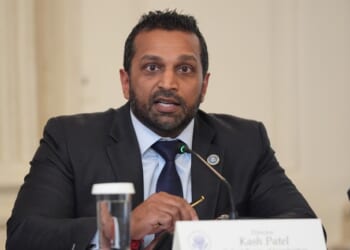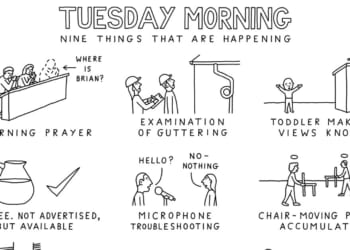
Seeing local news coverage of a church picnic usually wouldn’t raise an eyebrow. But this one caught my attention — it was hosted by a pastor I’d once known well, and the event was promoted as a “celebration of love and inclusion” for those who had attended the town’s pride parade.
At first, I assumed it might be an outreach — a chance to share the Gospel with people who rarely set foot in church. But a quick look at the church’s website told a different story. This congregation, once solidly Evangelical, now proudly affirmed LGBT identities and behaviors.
A friend who shared my concern asked if I would join her in meeting with the pastor. She had known him for years — he had baptized her daughter when she was a young teenager. Back then, he spoke clearly about the goodness of God’s design for male and female. I remembered hearing him lament that professors at his seminary were “pushing pro-gay theology” and how dismayed he was by the drift in the Church.
Now, the drift had reached his own pulpit.
When we arrived at his office, the change was visible before a word was spoken. Rainbow symbols appeared in the artwork on his walls and in the books on his shelves. My friend began by sharing the heartbreaking story of how her daughter had been drawn into gender ideology during the pandemic.
Her daughter, who had shown no prior confusion about her identity, was pulled in through an online group where an adult identifying as “trans” began grooming her. Within months, she was insisting she was a boy and demanding that her family affirm her new identity. She eventually cut off contact with her parents. My friend spoke through tears about her attempts to reach her daughter, her fears for her safety, and the devastating discovery that she was living with a man who was a convicted child molester.
The pastor listened intently, clearly moved. As a father himself, he could imagine the pain of a child lost to deception. But when my friend asked whether he saw her as unloving for not affirming her daughter’s new identity, his answer revealed a troubling change. He began to recite familiar “affirming” talking points about acceptance and dignity. He hesitated, recognizing that the woman sitting before him was not motivated by hate, but by love — a mother desperate to rescue her daughter.
We gently reminded him of the truths he had once preached: that God’s Word is clear about our being made in His image, and on human sexuality, and that compassion never requires us to call sin good. I asked him what had caused him to change his mind. He said that during seminary, he had pursued further studies in social justice and been drawn to the idea of interpreting Scripture through “the lens of love.” He now believes experience and reason have become as authoritative for him as Scripture. He also no longer believes that Jesus is the only way to God or salvation.
That’s when I realized this wasn’t just a change in emphasis — it was a change in foundation. Once a pastor moves Scripture from the top of the hierarchy to one of several “sources,” the entire framework of truth comes undone.
He went on to repeat the familiar arguments: that the Bible doesn’t condemn loving same-sex relationships, that the word “homosexual” wasn’t in the text until modern translations, and that the biblical prohibitions were only about exploitation. When I asked if he’d read Dr. Robert Gagnon’s The Bible and Homosexual Practice, he said he had — but I could tell the conclusions no longer held weight for him.
The longer we talked, the clearer it became: he hadn’t simply changed his interpretation of a few verses; he had adopted a different gospel. He said, “No one really knows what’s right or wrong. I’m just trying to reach people who are LGBT.” He even suggested that my ministry to equip churches in biblical sexuality was reaching people “in a different way” — as if two opposite messages could somehow work together.
As I looked around his office — at the rainbow decor, the absence of Scripture on the walls, the hesitation in his voice when he prayed — I grieved. This was a man who once led people to repentance and freedom in Christ, now bound by the culture’s shallow ideas of love and reality. His compassion, untethered from truth, had been weaponized against the very Gospel he once preached.
When pastors begin to drift on biblical sexuality and gender, it rarely begins with open rebellion. It starts, as it did for this one, with small shifts in language and emphasis.
They stop calling sin what God calls sin. They begin talking about “journeys,” “stories,” and “inclusion.” The word repentance fades, replaced by acceptance. Genesis 1 and 2 become “poetic.” Scripture is still quoted, but selectively, and the creation order of male and female is treated as symbolic rather than real.
The next stage is uncertainty. “This is a complex issue,” they say, or “Faithful Christians disagree.” They frame ambiguity as humility. But Jesus and the apostles never treated sexual morality as unclear. The Bible speaks directly and consistently, from Genesis to Revelation, about God’s design for marriage and the sin of same-sex behavior.
Soon, the church’s partnerships begin to shift. Some ministries and conferences once known for clarity begin to invite “Side B” speakers who identify as “gay Christians.” Others invite speakers actively involved in same sex “marriages.” Sermons begin quoting authors who reinterpret Scripture to fit modern categories. A pastor may insist nothing has changed, yet every cue — from language to leadership — says otherwise.
When clarity disappears from the pulpit, confusion spreads in the pews. Faithful members start to feel uneasy, sensing that something is off, but they are unable to pinpoint it. Those who raise questions are told they are divisive or unloving. Over time, conviction gives way to silence.
Behind all of it is a misplaced compassion — one that seeks to spare people from discomfort rather than deliver them from sin. True compassion tells the truth. Jesus never affirmed people in their brokenness; He called them to new life. “Neither do I condemn you,” He said to the woman caught in adultery. “Go and sin no more.” The love of Christ demonstrates that grace and truth are inseparable. When a pastor separates them, heresy is not far behind.
If you notice these signs in your own church, take them seriously. Don’t dismiss them as “just semantics.” Changes in vocabulary often signal deeper shifts in theology. As Paul warned, “The time will come when people will not endure sound teaching … but will turn aside to myths” (2 Timothy 4:3–4).
Pray for your pastors. Ask honest questions. Review your church’s statement of faith. And if necessary, seek fellowship where Scripture, not culture, defines truth.
For a fuller resource on identifying these patterns, you can download a free Discernment Guide: Recognizing a Pastor’s Drift on Biblical Sexuality & Gender — a practical tool with checklists and questions for church leaders — at https://loveandtruthnetwork.com/discernment
Debra Baty is the author of the Resources4Redemption newsletter. She has served on the Global Council of the Wesleyan Covenant Association and chaired their task force on sexuality and gender.
















